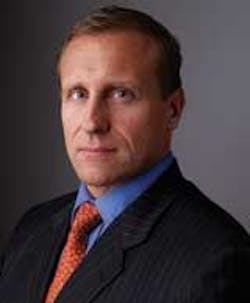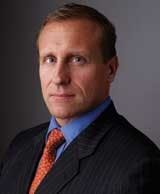Interview with StemSave's Dr. Gregory Chotkowski
by Jeffrey B. Dalin, DDS, FACD, FAGD, FICD
For more on this topic, go to www.dentaleconomics.com and search using the following key words: StemSave, stem cells, multipotent, pluripotent, Dr. Gregory Chotkowski, Dr. Jeff Dalin
Dr. Dalin: I met Dr. Greg Chotkowski at this year's Chicago Midwinter Meeting. He has helped develop a new company named StemSave. We have heard about stem cells and the promise they have in the development for treatment of a variety of diseases and situations. Why did you start this company?
Dr. Chotkowski: I was inspired to start StemSave because of my 12–year–old son, August. He is afflicted with a terminal muscle–wasting disease, Duchenne Muscular Dystrophy. After spending years talking to the world's leading scientists, as well as conducting extensive research personally, it became clear that stem cells would play an invaluable role in providing a cure for my son's disease. In addition, stem cells could impact a multitude of other degenerative diseases such as diabetes, Parkinson's, and Alzheimer's.
In addition to being a parent, I am also an oral and maxillofacial surgeon. In my job, I was annually discarding thousands of third molars, deciduous, and other teeth with healthy pulp tissue. So you can imagine my excitement when I found out that stem cells exist in the pulp of teeth. I then realized I had access to a valuable source of stem cells daily.
I thought that, if I could figure out a way for these stem cells to be recovered during a planned dental procedure and cryopreserved, then people could have access to their stem cells for medical treatments. People who have had transplants will tell you that, when your own cells are re–implanted, it virtually eliminates the need for immunosuppressive drugs.
Dr. Dalin: Researchers around the world are doing many exciting things with stem cells. While much about this topic is in the early stages of investigation, I would think we have a good idea of what effects stem cells can have on general health care. I understand that you can take stem cells from teeth and turn them into other types of tissues such as pancreatic islet cells for diabetics, dopamine–producing cells for those with Parkinson's, and muscle cells for those with muscular dystrophy. Would you discuss these exciting possibilities, particularly for those readers who have relatives or friends with any of these ailments?
Dr. Chotkowski: First, we need to define what stem cells are. Stem cells are the reparative cells of the body. They naturally repair damaged and injured tissues. Aging is a degenerative process. As we age, stem cells lose their ability to repair tissues. There are two main types of stem cells: embryonic and adult.
The main differences between the two are their origins. Embryonic stem cells are recovered at the fourth or fifth day after fertilization of an egg. These stem cells are pluripotent. They could ultimately differentiate or turn into the 220 different tissue types that make up a human being.
Adult stem cells are more differentiated, found in mature tissue, and are multipotent. They are limited to the type of tissue cells they are able to differentiate or develop into. Stem cells do not know what type of tissue to develop into. They rely on intrinsic and extrinsic factors, along with the environment, in order to determine their type of tissue cell.
Outside of the body (in vitro), adult stem cells can take on pluripotential characteristics. They can be plastic and transdifferentiate into a number of different tissue types other than the tissue from which they were recovered. An example of this would be stem cells recovered from the pulp of a healthy tooth and in the laboratory under controlled conditions that are directed to transdifferentiate into cells creating nerve tissue, muscle, and even beta islet cells that produce insulin.
If technicians are able to control the growth of these cells outside of the body and produce a sufficient quantity of these new cells over a relatively short period of time, they could be reimplanted into an individual. These newly introduced cells could then repair diseased or injured tissues or organs. Ultimately, this could provide a cure for degenerative diseases, such as Parkinson's and Alzheimer's, or a disease like diabetes.
Dr. Dalin: StemSave harvests cells from extracted teeth in a simple, straightforward process. Take us through the steps, from beginning to end, that practicing dentists would have to follow.
Dr. Chotkowski: The StemSave recovery and cryopreservation service was developed by dentists for dentists. Before formulating a business plan for our service, we conducted several focus groups with dental professionals. Two common themes stood out in each group that we interviewed. One theme was education. Dentists wanted us to provide them with the necessary scientific information about stem cells so they could feel comfortable offering our service to their patients. The second theme was that it had to be simple. We achieved both.
One of our core corporate mandates is to educate the dental professional about the valuable and accessible source of stem cells found in teeth. We helped develop several CE courses that are available on our Web site. Dental professionals can visit StemSave at www.stemsave.com, go to the “Dental Professionals” tab, and visit the “Stem Cell CE Credits” section. Also, there is research on the Web site for dental professionals and patients to be educated on dental stem cells.
We created a simple recovery process and made integrating our service into a dental practice seamless. StemSave's patented recovery and transport kit was designed in conjunction with stem cell researchers, biologists, cold chain solution experts, and transportation specialists. The result is a system that requires no refrigeration or pre–prep. This saves significant time and effort on behalf of the busy dental professional. The kit induces hypothermia in recovered teeth at room temperature so the kit is ready to use off the shelf.
The recovery process begins once the teeth are removed. Up to four teeth can be placed into the vial containing the nourishing solution. One healthy tooth is sufficient for recovery, but we will accept up to four. Once the teeth are secured in the kit, getting it picked up and rushed to our lab is easy. We have developed a Web application that integrates the patient, dental practice, StemSave, and UPS for delivery and pick up.
After recovery, a dental professional has only to log on to the StemSave Web site using his or her unique username and password to take advantage of the “Easy Ship” process. UPS is notified. There is no paperwork, and no phone calls to make. The total time for recovery and to have a kit ready for UPS pick up is less than three minutes.
Dr. Dalin: So all dentists need to do is have a patient purchase the Stem Save service, and place the extracted teeth into the transportation kit. The rest then is between your company and the patient while dentists are out of the picture.
Dr. Chotkowski: Exactly. Patients who are interested in preserving stem cells simply enroll on the Web site at www.StemSave.com. During enrollment, we require they enter basic demographic information, age, gender, and the type of teeth being recovered. We have several payment plans available. Patients would select the one best suited to them.
We personalize a patient's kit with his or her name and UIN (Unique Identification Number), and send the kit to the dentist's office for the patient in time for recovery. StemSave does all of the administrative work and collection of payment. We arrange for shipment of the kit from the dentist's office to our processing and cryopreservation facility.
Dr. Dalin: I understand the cost for patients to purchase a kit is $590, then $100 per year after that. The dentist does not have to purchase kits?
Dr. Chotkowski: All we require of dental professionals is for proper recovery of the tissue and to make sure they hand the kit off to a UPS driver. Transportation logistics are automated through StemSave's system, but we still rely on the dental practice to get the kit to UPS for pick up.
Dr. Dalin: What can dentists do to help spread the word about this program?
Dr. Chotkowski: We are partnering with dental professionals to make patients aware that they have the opportunity to recover valuable stem cells affordably and noninvasively when they undergo routine procedures, such as extraction of baby teeth, wisdom teeth, or other teeth with healthy pulp.
StemSave provides necessary patient information materials to dentists, as well as a professional informational packet that includes information on tooth eligibility, proper recovery procedures, and FAQs. Patient brochures and informational stem cell posters can be placed throughout the patient areas of an office.
StemSave would like for dental professionals to make patients aware that they offer this service. We ask them to direct patients to www.stemsave.com to find research and information that will educate patients on the potential of stem cells and their use in regenerative medicine to treat disease and trauma. In this way, patients can make an informed decision to save their stem cells.
Dr. Dalin: Do you plan to publicize your service to patients through the media?
Dr. Chotkowski: This past year we have focused our attention on educating and raising the awareness among dental professionals. We think it is important that dentists have a basic understanding about stem cells, and the potential they have for future regenerative therapies.
We will continue to educate dental professionals, but we are beginning to focus attention on the consumer market. We want to make the public aware that dentists can provide this valuable service when they are undergoing a routine procedure. Dentists are playing an expanding role in the overall health of patients.We believe that providing an affordable and noninvasive method for an individual to save stem cells will be one of the most important services dental professionals can offer in the future.
Dr. Dalin: While stem cell research is somewhat controversial, I think this interview shows that there is no reason to be afraid of StemSave's program. To repeat, this service is strictly using extracted teeth that otherwise end up in waste receptacles.
Dr. Chotkowski: There are no moral or ethical issues associated with recovering and cryopreserving stem cells from teeth. Stem cells found in teeth are a valuable source of stem cells that are being discarded as medical waste daily. StemSave provides a service that allows an individual the opportunity to recover and preserve their stem cells for future regenerative therapies.
Gregory Chotkowski, DMD, is the president of StemSave and an oral and maxillofacial surgeon. A graduate of Boston College and Tufts University School of Dental Medicine, he completed his residency in oral and maxillofacial surgery at Cornell University/New York Presbyterian Hospital. Reach him at [email protected].
Jeffrey B. Dalin, DDS, FACD, FAGD, FICD, practices general dentistry in St. Louis. He is the editor of St. Louis Dentistry magazine, and spokesman and critical–issue–response–team chairman for the Greater St. Louis Dental Society. Contact him at [email protected].

